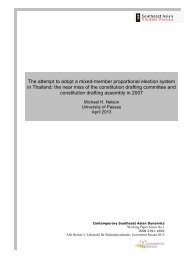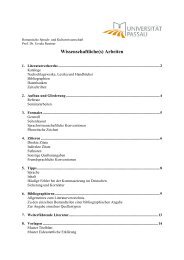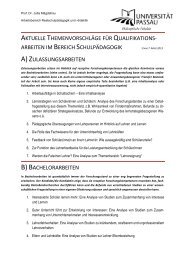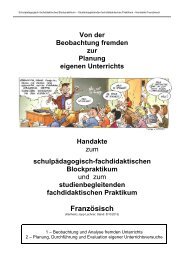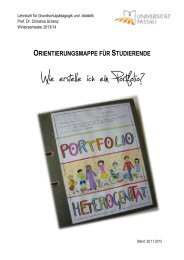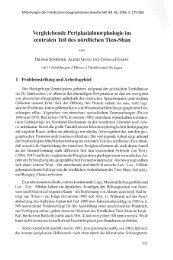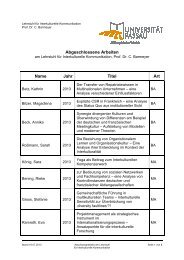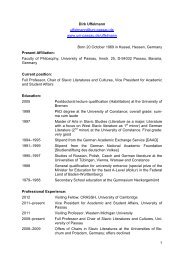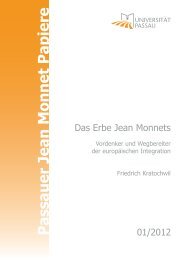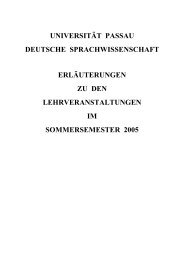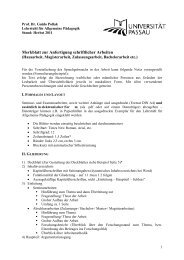How to Write a Research Paper/ Essay â Style Sheet â - Universität ...
How to Write a Research Paper/ Essay â Style Sheet â - Universität ...
How to Write a Research Paper/ Essay â Style Sheet â - Universität ...
You also want an ePaper? Increase the reach of your titles
YUMPU automatically turns print PDFs into web optimized ePapers that Google loves.
<strong>How</strong> <strong>to</strong> <strong>Write</strong> a <strong>Research</strong> <strong>Paper</strong>/ <strong>Essay</strong><br />
– <strong>Style</strong> <strong>Sheet</strong> –<br />
1. Principles of Academic Writing<br />
1.1. <strong>Research</strong> as Exploration and Communication<br />
We undertake research in order <strong>to</strong> explore an idea, investigate an issue, solve a<br />
problem, and make an argument.<br />
The research paper is generally based on a combination of primary (e.g. novel, film,<br />
text, performance, interviews) and secondary sources (e.g. articles, books, scientific<br />
debates).<br />
<strong>Research</strong> entails discovering, adopting, and assessing others’ research and developing,<br />
articulating, and summarising one’s own ideas.<br />
A research paper is a form of written communication that follows a set of<br />
conventions.<br />
1.2. Selecting a Topic<br />
Your paper should relate <strong>to</strong> an important aspect of the seminar.<br />
The <strong>to</strong>pic of your research paper needs <strong>to</strong> be problem-oriented: narrow your <strong>to</strong>pic<br />
by focussing on a single aspect of the subject or a particular approach <strong>to</strong> the problem.<br />
You can use methods of brains<strong>to</strong>rming, mind-mapping, and clustering <strong>to</strong> find your<br />
focus.<br />
If your choice is limited by a particular list of essay <strong>to</strong>pics you still need <strong>to</strong> decide<br />
which aspects <strong>to</strong> explore or which approach <strong>to</strong> use.<br />
Come up with a good and pointed title.<br />
Instead of “Mary Shelley’s Frankenstein” rather use<br />
“The Conflict between Religion and Science in Mary Shelley’s Frankenstein (1818)”<br />
1.3. General Structure<br />
Any research paper contains an introduction, main part, and conclusion.<br />
The introduction includes (1) a teaser and lead-in <strong>to</strong> the <strong>to</strong>pic with a his<strong>to</strong>rical and/<br />
or cultural contextualisation of your <strong>to</strong>pic, (2) your central questions and hypothesis,<br />
(3) a brief outline of the structure and approach of your research paper.<br />
Anglistik/Amerikanistik – <strong>Style</strong> <strong>Sheet</strong> –<br />
Universität Passau<br />
1
The main part (1) introduces and elaborates specific theories and methods relevant<br />
<strong>to</strong> your research <strong>to</strong>pic and (2) contains an interpretation of relevant primary sources;<br />
your interpretation serves the development and specification of your main arguments.<br />
The conclusion consists of (1) a brief summary of the arguments and interim results<br />
developed in the main analysis. (2) It answers the main question by referring <strong>to</strong> the<br />
meta-level of the <strong>to</strong>pic (see explanation below) and (3) possibly lists further open<br />
questions.<br />
The overall structure of any research paper is based on the so-called “Hour-Glass Model”:<br />
<br />
<br />
<br />
<br />
Your paper begins on a general thematic meta-level.<br />
Narrow the scope of your paper <strong>to</strong> specific aspects<br />
by means of explanation, qualification, and/or<br />
definition.<br />
The main part of your research paper provides<br />
specific examples which illustrate and specify your<br />
<strong>to</strong>pic in reference <strong>to</strong> context and texts. It supports your<br />
line of argumentation by offering examples (direct and<br />
indirect quotations) from your primary material.<br />
Structure your main ideas by concise paragraphing!<br />
The summary provides answers <strong>to</strong> your main question<br />
and subsequently relates the results <strong>to</strong> the overall<br />
meta-level of the <strong>to</strong>pic. You can, for example, end<br />
your analysis by referring back <strong>to</strong> the title or the teaser<br />
of your paper.<br />
Hour-Glass Model<br />
1.4. Paragraphing<br />
Use a <strong>to</strong>pic sentence for each paragraph; each paragraph should focus on and<br />
elaborate the subject introduced in the <strong>to</strong>pic sentence. Each <strong>to</strong>pic sentence should<br />
relate <strong>to</strong> the <strong>to</strong>pic of your paper and develop the main argument.<br />
A paragraph is a unit of thought: a paragraph consists of several sentences that<br />
develop one line of argument step-by-step, i.e. the sentences illustrate, specify, and<br />
exemplify the central issue of the <strong>to</strong>pic sentence.<br />
Avoid one- or two-sentence paragraphs.<br />
The last sentence of each paragraph should establish a link <strong>to</strong> the next one.<br />
Each new paragraph is either indented or separated from the former paragraph by a<br />
blank line.<br />
Anglistik/Amerikanistik – <strong>Style</strong> <strong>Sheet</strong> –<br />
Universität Passau<br />
2
1.5. Best Practice: Textual Analysis and Logical Argumentation<br />
Never simply summarise or describe the text you are analysing. Your paper should<br />
present a well-informed interpretation of the primary source.<br />
Support your ideas with concrete examples, references or quotations from the text.<br />
Explain and elaborate the textual references. Do not let quotations stand by<br />
themselves.<br />
Support your argument by referring or quoting from relevant secondary sources.<br />
Use secondary literature adequately. Others’ thoughts should not crush your selfdeveloped<br />
ideas.<br />
Assure that you document your sources correctly.<br />
Pay attention <strong>to</strong> argumentative conclusiveness.<br />
Avoid redundancies or red herrings.<br />
2. Language, <strong>Style</strong>, and Grammar<br />
Seminar papers and essays must be written in English. Effective writing depends on clarity,<br />
analytical precision, and readability. Pay attention <strong>to</strong> scientific language, diction, sentence<br />
structure, grammar, spelling, punctuation, capitalisation, coherence.<br />
2.1. Scientific Language<br />
Good scholarship requires objectivity and avoids language that implies insubstantial or<br />
irrelevant generalisations.<br />
Dos<br />
Don’ts<br />
<br />
Use appropriate scientific language and<br />
<br />
Avoid subjective opinions and<br />
terminology.<br />
statements (e.g. “I suppose”).<br />
<br />
The sparing use of “I” or “my” in the<br />
<br />
Avoid the frequent use of the first<br />
introduction or conclusion is okay.<br />
person (e.g. “I think”, “I will”).<br />
2.2. <strong>Style</strong><br />
Dos<br />
Don’ts<br />
<br />
Use the present tense when writing<br />
<br />
Do not use sentence fragments, even<br />
about literary works, essays, paintings,<br />
for effect.<br />
etc.<br />
<br />
Avoid the frequent use of the passive<br />
<br />
Use short concrete sentences.<br />
voice.<br />
Anglistik/Amerikanistik – <strong>Style</strong> <strong>Sheet</strong> –<br />
Universität Passau<br />
3
Use scientific language.<br />
<br />
Avoid clichés and slang.<br />
<br />
Use a Thesaurus.<br />
<br />
Avoid meaningless filler words.<br />
2.3. Spelling<br />
Spelling should be consistent throughout the research paper.<br />
Dos<br />
When you use quotations, you must<br />
reproduce all accents and other marks as<br />
they appear in the original.<br />
Use spell check.<br />
Proofread the paper.<br />
<br />
<br />
<br />
Don’ts<br />
Do not misspell words.<br />
Do not mix American and British<br />
English.<br />
Avoid contractions (e.g. don’t, it’s).<br />
2.4. Punctuation<br />
Punctuation clarifies sentence structure.<br />
Use a comma<br />
<strong>to</strong> join two independent clauses. The comma must be followed by a coordinating<br />
conjunction (and, but, or, for, so, yet).<br />
<strong>to</strong> separate three or more words, phrases, and clauses in a series.<br />
<strong>to</strong> set off introduc<strong>to</strong>ry phrases and clauses.<br />
Use a semicolon<br />
between independent clauses not linked by a conjunction.<br />
between items in a series when the item contains commas.<br />
Use a colon<br />
<strong>to</strong> introduce a list, an elaboration, the formal expression of a rule.<br />
<strong>to</strong> introduce a quotation that is independent from the main sentence.<br />
Examples:<br />
Congress passed the bill, and the president signed it in<strong>to</strong> law.<br />
The poem is ironic, for the poet’s meaning contrasts with her words.<br />
Shakespeare has inspired films, operas, paintings.<br />
Instead of eating half a cake or a dozen cookies, I now grab a banana.<br />
Critics praise the novel’s unaffected, unadorned style.<br />
The angry villagers, who carried <strong>to</strong>rches, threatened the scientist.<br />
The coat is tattered; I hope <strong>to</strong> mend it.<br />
The plot is founded on deception: the three main characters have secret identities.<br />
Anglistik/Amerikanistik – <strong>Style</strong> <strong>Sheet</strong> –<br />
Universität Passau<br />
4
2.5. Capitalisation<br />
In a title, subtitle, or whenever you cite the title from a published work capitalise the first<br />
and all following principal words including those that follow hyphens or compound terms.<br />
Capitalise<br />
nouns, pronouns, verbs, adjectives, adverbs,<br />
subordinating conjunctions:<br />
The Flower of Europe, Save Our Children,<br />
This Is Literature, The Ugly Duckling, Only<br />
Slightly Corrupt, One If by Land<br />
Do Not Capitalise<br />
articles, prepositions, coordinating<br />
conjunctions, "<strong>to</strong>" in infinitives:<br />
Under the Bamboo Tree, The Merchant of<br />
Venice, Romeo and Juliet, <strong>How</strong> <strong>to</strong> Play<br />
Chess.<br />
3. Formal Aspects: Layout Conventions<br />
All papers must be word-processed. A research paper contains the following elements: title<br />
page, contents page, text, list of works cited, declaration of authorship<br />
(Eigenständigkeitserklärung).<br />
3.1. Title Page<br />
The title page features (1) context information: university, title of the seminar, name of<br />
instruc<strong>to</strong>r, semester in which the seminar <strong>to</strong>ok place; (2) information about yourself and<br />
your paper: title of the seminar paper/ essay, name, address, email address, student number<br />
(Matrikelnummer), course of study, date when you handed in the paper, word count, and,<br />
most importantly, requested credit allocation (i.e. Art der Prüfungsleistung und<br />
Prüfungsnummer). You can download a template of the title page from our homepage.<br />
Sample Title Page<br />
Anglistik/Amerikanistik – <strong>Style</strong> <strong>Sheet</strong> –<br />
Universität Passau<br />
5
3.2. Word Count<br />
Proseminar Basismodul/ Grundlagenmodul 2 x 2,000 words +/- 10%<br />
Prüfungsmodul/ Vertiefungsmodul 1 x 5,000 words +/- 5%<br />
Hauptseminar 1 x 7,000 words +/- 5%<br />
3.3. Contents Page<br />
Sample Contents Page (of a paper with the <strong>to</strong>pic “The Female Cultural Sphere in 19th-<br />
Century American Short Fiction by Women: Kate Chopin and Charlotte Perkins Gilman”)<br />
Contents<br />
1. Introduction<br />
2. The Female Cultural Sphere in the U.S. in the Second Half of the 19 th Century<br />
2.1. The Cult of True Womanhood<br />
2.2. Female Social Reform and the Early Feminist Movement<br />
3. The Female Sphere in 19 th -Century Fiction<br />
3.1. Local Color vs. Regionalism<br />
3.2. Breaking with Literary and Cultural Conventions and Taboos<br />
4. Kate Chopin and Charlotte Perkins Gilman as Case Studies<br />
4.1. Kate Chopin: Local Color Writing as Female Agenda<br />
4.2. Charlotte Perkins Gilman: Social Reforms as Driving Force<br />
5. Conclusion<br />
Works Cited<br />
1<br />
2<br />
2<br />
3<br />
4<br />
4<br />
5<br />
6<br />
6<br />
9<br />
12<br />
13<br />
All the headings on the contents page should be equivalent <strong>to</strong> the headings in the text.<br />
Dos<br />
Don’ts<br />
<br />
The headings should tell a ‘s<strong>to</strong>ry’ and<br />
<br />
Avoid literal repetitions of headings<br />
give a first impression of how you<br />
(e.g. 2. Women's Liberation, 2.1.<br />
develop your <strong>to</strong>pic.<br />
Women's Liberation and<br />
<br />
There is always an “Introduction” and a<br />
Counterculture).<br />
“Conclusion”.<br />
<br />
Avoid filler words, one-worded<br />
<br />
Choose <strong>to</strong>pic headings or sub-headings<br />
headings, generalisations, questions,<br />
which outline the content of your paper.<br />
and specialised terms.<br />
Anglistik/Amerikanistik – <strong>Style</strong> <strong>Sheet</strong> –<br />
Universität Passau<br />
6
Sub-headings serve the clarification of<br />
main headings.<br />
Begin pagination with the Introduction.<br />
Number all pages consecutively<br />
throughout the research paper.<br />
If necessary place the List of<br />
Abbreviations/ Figures/ Tables after<br />
the Contents page.<br />
If there is an Appendix (Anhang), it is<br />
placed after the Works Cited pages.<br />
Avoid more than three levels for the<br />
structure of the paper (hence no<br />
2.1.1.1. etc.)<br />
Do not use sub-headings if you only<br />
have one sub-item (e.g. if you write 2.1.<br />
you must at least write 2.2.).<br />
Do not add a number before “Works<br />
Cited”.<br />
Do not use the abbreviation “p.”<br />
before a page number.<br />
Do not include the “Declaration of<br />
Authorship” in the Contents.<br />
3.4. Page Layout<br />
Margin: 3 cm on each side.<br />
Font: with serifs (e.g. Garamond, Georgia, Times New Roman) in the standard size<br />
of 12 points.<br />
Spacing: 1.5 in the body of the text.<br />
Setting: full justification (Blocksatz)!<br />
Set-off quotations: Direct quotations that are longer than three lines are indented<br />
on the left margin (1 cm) and set <strong>to</strong> 10 points, 1.0 spacing, and full justification (see<br />
example on page 12).<br />
3.5. Works Cited<br />
The list of works cited appears at the end of your paper.<br />
Begin the list on a new page and number all pages.<br />
As the heading “Works Cited” indicates, this list only contains works (including<br />
DVDs or other media) that you cite in your text.<br />
The list of works cited should be broken down in<strong>to</strong> primary and secondary sources/<br />
literature.<br />
Entries in the list are arranged in alphabetical order by the author’s last name (or, if<br />
the name is unknown, by the title of the publication).<br />
If an entry runs more than one line, indent the subsequent line or lines.<br />
Anglistik/Amerikanistik – <strong>Style</strong> <strong>Sheet</strong> –<br />
Universität Passau<br />
7
To cite two or more works by the same author, give the name in the first entry only.<br />
Thereafter, in place of the name, type three hyphens which stand for exactly the<br />
same name as in the preceding title.<br />
You can use programmes like CITAVI <strong>to</strong> generate your Works Cited list and<br />
document your sources. The university library offers schoolings on CITAVI.<br />
Sample Works Cited Page<br />
Anglistik/Amerikanistik – <strong>Style</strong> <strong>Sheet</strong> –<br />
Universität Passau<br />
8
3.6. Declaration of Authorship<br />
Eigenständigkeitserklärung<br />
Hiermit bestätige ich, dass sich die vorliegende Arbeit selbständig verfasst und keine<br />
anderen als die angegebenen Hilfsmittel benutzt habe. Die Stelle der Arbeit, die dem<br />
Wortlaut oder dem Sinn nach anderen Werken (dazu zählen auch Internetquellen)<br />
entnommen sind, wurden unter der Angabe der Quelle kenntlich gemacht. Die Arbeit<br />
ist nicht bereits in einem anderen Seminar vorgelegt worden.<br />
Ort, Datum<br />
Unterschrift<br />
4. Conducting <strong>Research</strong><br />
4.1. The Library<br />
The library is your most reliable guide as you conduct research for papers.<br />
Ask about introduc<strong>to</strong>ry pamphlets or use the guided <strong>to</strong>urs and introduc<strong>to</strong>ry classes<br />
offered by the library.<br />
Library resources include electronic resources (e.g. online catalogue, reference works,<br />
bibliographic and full-text databases, e-books), print resources (e.g. books, journals,<br />
newspapers, magazines), and other non-print media (e.g. films, sound recordings)<br />
4.2. A Selection of Useful <strong>Research</strong> Sources<br />
Library Open Shelves:<br />
sections for reserved works, reference works, key<br />
text collections, textbook collection, periodicals<br />
Library Online Information System at the Universitätsbibliothek Passau:<br />
<br />
<br />
Library Catalogue of Holding Loan (Präsenzbestand and Magazin): InfoGuide<br />
Library Catalogue of Inter-Library Loan (Fernleihe): Bibliotheksverbund Bayern<br />
(BVB)<br />
Bibliographic Databases:<br />
Full-Text Databases:<br />
MLA, Virtual Library of Anglo American Culture<br />
ARTs<strong>to</strong>r, Early English Books Online, JSTOR,<br />
Project Gutenberg, Project Muse, etc.<br />
Media Centre: Sprachenzentrum Videothek, NK R 315<br />
Anglistik/Amerikanistik – <strong>Style</strong> <strong>Sheet</strong> –<br />
Universität Passau<br />
9
4.3. Searching a Catalogue or Reference Database<br />
The following items may help you <strong>to</strong> find the source you are looking for in an online<br />
library catalogue:<br />
<br />
Author<br />
<br />
Title<br />
<br />
Subject<br />
<br />
Keyword<br />
<br />
Form of Publication<br />
<br />
Year of Publication<br />
<br />
Call Number (Signatur)<br />
<br />
International Standard Book Number (ISBN)<br />
4.4. Evaluating and Keeping Track of Source Material<br />
Evaluate all sources you use for your research.<br />
Focus on authority, accuracy, and currency of the sources<br />
Enter the full information about the sources in<strong>to</strong> a file.<br />
When you add sources <strong>to</strong> your working bibliography, be sure <strong>to</strong> enter all the<br />
information needed for the works-cited list.<br />
Whenever you consult a source, verify the publication facts against your records.<br />
5. Documentation of Sources<br />
5.1. Plagiarism<br />
YOU ALWAYS NEED TO DOCUMENT YOUR SOURCE<br />
when you are quoting, paraphrasing or summarising ideas and arguments.<br />
OTHERWISE YOU ARE COMMITTING<br />
PLAGIARISM.<br />
Plagiarising results in a fail!<br />
<br />
<br />
<br />
Plagiarism is not crediting another author for his/her ideas. To plagiarise means <strong>to</strong><br />
commit literary or intellectual theft. Plagiarising constitutes fraud.<br />
General forms of plagiarism: paraphrasing wording, taking a particular apt phrase,<br />
presenting an identical line of thinking, one-on-one translation without<br />
documentation.<br />
Only information and ideas broadly known by your readers and widely accepted by<br />
scholars, such as the biography of an author or the dates of his<strong>to</strong>rical events, can be<br />
used without documentation.<br />
Anglistik/Amerikanistik – <strong>Style</strong> <strong>Sheet</strong> –<br />
Universität Passau<br />
10
5.2. MLA Documentation <strong>Style</strong><br />
When quoting your source material and documenting it in “Works Cited”, make sure that<br />
you adhere <strong>to</strong> the MLA (Modern Language Association) documentation style<br />
(www.mla.org/style). The basic MLA guidelines are explained in the following. If you have<br />
further questions, please consult the current edition of the The MLA Handbook for<br />
<strong>Write</strong>rs of <strong>Research</strong> <strong>Paper</strong>s which is on loan from our library.<br />
For all papers, use the so-called parenthetical (in-text-citation) style! This means<br />
that when you quote from a book, an article, or any other source, the quotation<br />
should be followed by a parenthetical citation giving the page number where the<br />
quotation can be found.<br />
Footnotes are only used for necessary explana<strong>to</strong>ry remarks or content-related<br />
comments.<br />
References in the text must clearly point <strong>to</strong> specific sources in the list of works<br />
cited.<br />
According <strong>to</strong> MLA guidelines, you must provide both the name of the author and<br />
the page number, e.g. (Müller 35).<br />
You may abbreviate the titles of primary sources, e.g. Brick Lane (BL 15), but<br />
should briefly explain the use of this abbreviation in a footnote or, when using<br />
several abbreviations, in a list of abbreviations.<br />
If the work has more than three authors (e.g. John Brown, Klaus Turm, Fred<br />
Smith, John Fry), give the first author’s last name followed by “et al.”, e.g. (Brown et<br />
al. 10).<br />
When referring <strong>to</strong> more than one work, use a semicolon <strong>to</strong> separate the citation, e.g.<br />
(Brown et al. 10; Müller 35).<br />
If you use more than one author with the same last name (e.g. Andrew Patterson<br />
and Lee Patterson), add the first letter of the first name, e.g. (A. Patterson 183-85), (L.<br />
Patterson 230).<br />
If you use more than one work by the same author (e.g. Homi K. Bhabha’s<br />
Nation and Narration and The Location of Culture), add a shortened version of the<br />
title, e.g. (Bhabha, Nation 25), (Bhabha, Location 85).<br />
If no author is given, cite a work by title, e.g. (“Noon”).<br />
When quoting a reference that is not originally from the source you have,<br />
include the abbreviation “qtd. in” (quoted in) before the indirect source in the<br />
parenthetical reference (e.g. Watt qtd. in Hunt and Jacob 493). <strong>How</strong>ever, citations<br />
Anglistik/Amerikanistik – <strong>Style</strong> <strong>Sheet</strong> –<br />
Universität Passau<br />
11
taken from a secondary source should generally be avoided; consult the original work<br />
whenever possible.<br />
The second and following parenthetical citation of the same source omits the<br />
author’s name, e.g. “aaaa” (Müller 12); “bbbb” (10).<br />
If the author’s name is already mentioned in the sentence containing the<br />
quotation, the following parenthetical citation omits the author’s name and only<br />
mentions the page number, e.g.: Smith points out that xyz (10); According <strong>to</strong> Smith,<br />
“xyz” (19).<br />
Direct references longer than three lines are indented (see above for layout<br />
specifications). Do not use quotation marks for these set-off quotations.<br />
When quoting from a poem refer <strong>to</strong> the lines in parentheses, e.g. (6-10).<br />
<br />
<br />
<br />
Examples:<br />
<br />
<br />
When quoting from a drama give number of act, scene, and lines in parentheses,<br />
e.g. (2.4.254-58).<br />
If you quote two <strong>to</strong> three lines from a poem within the continuous text use a slash<br />
( / ) <strong>to</strong> separate them.<br />
If you wish <strong>to</strong> omit a word or a sentence from the reference you are quoting, use<br />
ellipses: “[…]”. Ellipses are also used <strong>to</strong> align subject, verb form, and capitalisation,<br />
etc. in order <strong>to</strong> fit sentence fragments in<strong>to</strong> the continuous text, e.g. see below.<br />
Mary Davies describes the animal at East Mountain Reservation as “unlike any<br />
known <strong>to</strong> previous civilizations, strange and exotic <strong>to</strong> the human explorers” (176).<br />
The animals at East Mountain Reservation are “unlike any known <strong>to</strong> previous<br />
civilizations, strange and exotic <strong>to</strong> the human explorers” (Davies 176).<br />
“Remember that this sentence, like many others, is just an example.” (Müller 10)<br />
Müller stresses that “this sentence […] is just an example” (10).<br />
<br />
<br />
Stephen Greenblatt remarks:<br />
The ensemble of beliefs and practices that form a given culture function as a pervasive<br />
technology of control, a set of limits within which social behaviour must be contained, a<br />
reper<strong>to</strong>ire of models <strong>to</strong> which individuals must conform. (225)<br />
This notion can be applied <strong>to</strong> XYZ’s novel.<br />
Stephen Greenblatt, a literary critic and scholar, perceives “[t]he ensemble of beliefs<br />
and practices that form a given culture […] as a pervasive technology of control, a<br />
set of limits within which social behaviour must be contained, a reper<strong>to</strong>ire of models<br />
<strong>to</strong> which individuals must conform.” (225) This notion can be applied <strong>to</strong> XYZ’s<br />
novel.<br />
Anglistik/Amerikanistik – <strong>Style</strong> <strong>Sheet</strong> –<br />
Universität Passau<br />
12
5.3. Integrating Sources in Your Own Text<br />
Secondary sources can appear in your own text in three distinct ways:<br />
Quotations must be identical <strong>to</strong> the original; they use a narrow segment of the<br />
source document word for word:<br />
In his famous and influential work On the Interpretation of Dreams, Sigmund Freud<br />
argues that dreams are the “royal road <strong>to</strong> the unconscious” (5).<br />
Paraphrasing involves putting a passage from the source material in<strong>to</strong> your own<br />
words. Paraphrased material is usually shorter than the original passage. It takes a<br />
somewhat broader segment of the original source and condenses it slightly:<br />
Freud claims that dreams are a way for the dreamer <strong>to</strong> work through his/her<br />
unfulfilled wishes in coded imagery (8).<br />
Summarising involves putting the main idea of a secondary source in<strong>to</strong> your own<br />
words, including only the main aspects. Summaries are significantly shorter than the<br />
original and take a broad overview of the source material:<br />
According <strong>to</strong> Freud, actual but unacceptable desires are censored internally and then<br />
subjected <strong>to</strong> coding before emerging in a kind of rebus puzzle in our dreams (11-18).<br />
5.4. Bibliographical Format of References<br />
Author’s Name: Give the author’s name as it appears on the title page. Omit titles,<br />
affiliations, degrees, etc.<br />
Title: State the full title of the book, including any subtitle. Use a colon between<br />
main title and subtitle. Capitalise all titles (see 2.5.). (1) Italicise books, plays,<br />
collection of poems, pamphlets, periodicals, Web sites, films, albums, dance<br />
performances, visual art. (2) Put titles of articles, s<strong>to</strong>ries, poems, pages in a Web site,<br />
episodes, songs, lectures in quotation marks.<br />
Original Date of Publication: Give information of the first date of publication<br />
after the title followed by a full s<strong>to</strong>p.<br />
Publication Information: If several cities are listed in the book, give only the first.<br />
It is not necessary <strong>to</strong> identify the state or country. Only cite the last name of the<br />
publisher. Omit articles, business abbreviations, and descriptive words. When citing a<br />
university press use the abbreviation UP.<br />
Common Abbreviations: n.p. (no place of publication); n.p. (no publisher); n.d. (no<br />
date of publication); n. pag. (no pagination given).<br />
Anglistik/Amerikanistik – <strong>Style</strong> <strong>Sheet</strong> –<br />
Universität Passau<br />
13
Cross-References: Citing two or more works from the same collection, you may<br />
create a complete entry for the collection and cross-reference individual pieces <strong>to</strong> the<br />
entry.<br />
Type of Entry<br />
Book by a single author<br />
Works Cited List / Citation in Text<br />
Author’s last name, first name. Title of the Book. City of<br />
publication: Publisher’s name, year of publication. Medium of<br />
publication.<br />
Works Cited: Dreiser, Theodore. Sister Carrie. 1900. Introd. Richard<br />
Lingeman. New York: New Amer. Lib.-Penguin, 2000.<br />
Print.<br />
Nielsen, Jakob. Hypertext & Hypermedia. Bos<strong>to</strong>n: Academic<br />
Press Professional, 1993. Print.<br />
Citation in Text: (SC 55), (Nielsen 141)<br />
Book by more than one<br />
author<br />
First author’s last name, first name, and second author’s first<br />
name last name. Title of the Book. City of publication:<br />
Publisher’s name, year of publication. Medium of publication.<br />
Works Cited: Gilbert, Sandra M., and Susan Gubar. The Madwoman in the<br />
Attic. New Haven: Yale UP, 1979. Print.<br />
Guignery, Vanessa, and François Gallix, eds. (Re-)Mapping<br />
London: Visions of the Metropolis in the Contemporary<br />
Novel in English. Paris: Publibook, 2008. Print.<br />
Citation in Text: (Gilbert and Gubar 9)<br />
<strong>Essay</strong> in a Collection or<br />
Work in an Anthology<br />
Author’s last name, first name. “Title of Entry.” Title of the<br />
Collection/Anthology. Ed./ Trans./ Comp. Name of the<br />
edi<strong>to</strong>r/ transla<strong>to</strong>r/ compiler. City of publication: Publisher’s<br />
name, year of publication. Inclusive page numbers. Medium<br />
of publication.<br />
Anglistik/Amerikanistik – <strong>Style</strong> <strong>Sheet</strong> –<br />
Universität Passau<br />
14
Works Cited: Colvert, James B. “Stephen Crane.” Dictionary of Literary<br />
Biography. Ed. Donald Pizer. Vol. 12. Detroit: Gale, 1982.<br />
100-124. Print.<br />
Hooker, Thomas. “A True Sight of Sin.” The American<br />
Puritans: Their Prose and Poetry. Ed. Perry Miller. New<br />
York: Columbia UP, 1982. 153-164. Print.<br />
Citation in Text: (Colvert 120), (Hooker 154)<br />
Article in a reference<br />
book<br />
“Title of Entry.” Name of Reference Book. Edition of<br />
publication. Year of publication. Medium of publication.<br />
Works Cited: “Tutankhamen.” The New Encyclopaedia Britannica:<br />
Micropaedia. 15th ed. 1994. Print.<br />
Citation in Text: (“Tutankhamen”)<br />
Introduction/ Preface/<br />
Foreword/ Afterword<br />
Author’s last name, first name. “Title of Section.”<br />
Introduction/ Preface/ Foreword/ Afterword. Title of the<br />
book. Ed. Name of edi<strong>to</strong>r. City of publication: Publisher’s<br />
name, year of publication. Inclusive page numbers. Medium<br />
of publication.<br />
Works Cited: Coetzee, J. M. Introduction. The Confusion of Young Törless.<br />
By Robert Musil. Trans. Shaun Whiteside. New York:<br />
Penguin, 2001. v-xiii. Print.<br />
Citation in Text: (Coetzee vii)<br />
Scholarly Edition<br />
Author’s last name, first name. Title of the Book. Year of first<br />
publication. Ed. Name of edi<strong>to</strong>r. City of publication:<br />
Publisher’s name, year of publication. Medium of publication.<br />
Anglistik/Amerikanistik – <strong>Style</strong> <strong>Sheet</strong> –<br />
Universität Passau<br />
15
Works Cited: Crane, Stephen. The Red Badge of Courage: An Episode of<br />
the American Civil War. 1895. Ed. Fredson Bowers.<br />
Charlottesville: UP of Virginia, 1975. Print.<br />
Citation in Text: (Crane 65)<br />
Journal Article<br />
Author’s last name, first name. “Title of the Article.” Name<br />
of Periodical volume number.Issue number (date of<br />
publication): Inclusive page numbers. Medium of publication.<br />
Works Cited: Snodgrass, Susan. “The Rubbish Heap of His<strong>to</strong>ry.” Art in<br />
America 88.5 (2000): 156-7. Print.<br />
Citation in Text: (Snodgrass 156)<br />
Newspaper Article<br />
Author’s last name, first name. “Title of Article.” Name of<br />
Newspaper Date of Publication, specification of edition, sec.<br />
section number: page numbers. Medium of publication.<br />
Works Cited: Haughney, Christine. “Women Unafraid of Condo<br />
Commitment.” New York Times 10 Dec. 2006, late ed.,<br />
sec. 11: 1+. Print.<br />
Citation in Text: (Haughney 1)<br />
Magazine Article<br />
Author’s last name, first name. “Title of the Article.” Name<br />
of Magazine date of publication: Inclusive page numbers.<br />
Medium of publication.<br />
Works Cited: Cowley, Geoffrey. “I’d Toddle a Mile for a Camel.”<br />
Newsweek 23 Dec. 1991: 70-71. Print.<br />
Anglistik/Amerikanistik – <strong>Style</strong> <strong>Sheet</strong> –<br />
Universität Passau<br />
16
Citation in Text: (Cowley 70)<br />
Review<br />
Author’s last name, first name. “Title of Review.” Rev. of<br />
Title of Reviewed Text, by/ trans./ dir./ ed. Name of author.<br />
Title of Periodical Date of Publication: Inclusive Page<br />
number. Medium of publication.<br />
Works Cited: Mendelsohn, Daniel. “September 11 at the Movies.” Rev. of<br />
United 93, dir. Paul Greengrass, and World Trade Center,<br />
dir. Oliver S<strong>to</strong>ne. New York Review of Books 21 Sept.<br />
2006: 43-46. Print.<br />
Citation in Text: (Mendelsohn 44)<br />
Anonymous Article<br />
“Title of Article.” Name of Periodical Date of Publication:<br />
inclusive page numbers. Medium of publication.<br />
Works Cited: “Give Georgia More HOPE.” Atlanta Journal-Constitution<br />
18 Dec. 1994: G6. Print.<br />
Citation in Text: (“Give” G6)<br />
Web Publications<br />
Last name, first name of the author/ compiler/ direc<strong>to</strong>r/<br />
edi<strong>to</strong>r/ narra<strong>to</strong>r/ performer. “Title of the Work.” Title of the<br />
Overall Web Site. Publisher or sponsor, Date of publication.<br />
Medium of publication. Date of access. (URL optional).<br />
Works Cited: Antin, David. Interview by Charles Bernstein. Dalkey<br />
Archive Press. Dalkey Archive P. n.d. Web. 21 Aug. 2007.<br />
Eaves, Morris, Robert Essick, and Joseph Viscomi, eds. The<br />
William Blake Archive. Lib. of Cong., 28 Sept. 2007.<br />
Web. 20 Nov. 2007. http://www.blakearchive.org/blake/.<br />
Anglistik/Amerikanistik – <strong>Style</strong> <strong>Sheet</strong> –<br />
Universität Passau<br />
17
“Maplewood, New Jersey.” Map. Google Maps. Google, 15<br />
May 2008. Web. 15 May 2008.<br />
Oullette, Marc. “Theories, Memories, Bodies, and Artists.”<br />
Edi<strong>to</strong>rial. Reconstruction 7.4 (2007): n. pag. Web. 5 June<br />
2008.<br />
Quade, Alex. “Elite Team Rescues Troops behind Enemy<br />
Lines.” CNN.com. Cable News Network, 19 Mar. 2007.<br />
Web. 15 May 2008.<br />
Tyre, Peg. “Standardized Tests in College?” Newsweek.<br />
Newsweek, 16 Nov. 2007. Web. 15 May 2008.<br />
Citation in Text: (Antin), (“Maplewood”), (Oulette), (Quade), (Tyre)<br />
Article from an online<br />
database<br />
Author’s last name, first name. “Title of Article.” Title of<br />
Periodical volume number.issue number (Date of<br />
publication): Inclusive page numbers. Title of database.<br />
Medium of publication. Date of access. (URL optional).<br />
Works Cited: Tolson, Nancy. “Making Books Available: The Role of Early<br />
Libraries, Librarian, and Booksellers in the Promotion of<br />
African American Children’s Literature.” African<br />
American Review 32.1 (1998): 9-16. JSTOR. Web. 5 June<br />
2008.<br />
Citation in Text: (Tolson 11)<br />
Film<br />
Title of the Film. Dir. Name of direc<strong>to</strong>r. Screenplay by name<br />
of writer. Original release date. Name of the vendor, date of<br />
publication. DVD.<br />
Works Cited: Ned Kelly. Dir. Tony Richardson. Screenplay by Ian Jones.<br />
1970. MGM, 2005. DVD.<br />
Anglistik/Amerikanistik – <strong>Style</strong> <strong>Sheet</strong> –<br />
Universität Passau<br />
18
Citation in Text: (Ned Kelly 04:45:22)<br />
Song<br />
Last name, first name of performer. “Title of Recording.” by<br />
name of composer when distinct. Title of Album. Rec. date<br />
of recording. Manufacturer, year of issue. Medium<br />
(Audiocassette, Audiotape, CD, LP).<br />
Works Cited: Holliday, Billie. “God Bless the Child.” Rec. 9 May 1941. The<br />
Essence of Billie Holliday. Columbia, 1991. CD.<br />
Simon, Paul. “Me and Julio Down by the School Yard.”<br />
Concert in the Park. Warner Bros., 1991. CD.<br />
Citation in Text: (Holliday), (Simon)<br />
Work Cited:<br />
The Modern Language Association of America. MLA Handbook for <strong>Write</strong>rs of <strong>Research</strong><br />
<strong>Paper</strong>s. 7th ed. New York: MLA, 2009. Print.<br />
Further Introduc<strong>to</strong>ry Reading:<br />
Aczel, Richard. <strong>How</strong> <strong>to</strong> <strong>Write</strong> an <strong>Essay</strong>. Stuttgart: Klett, 2004. Print.<br />
Boeglin, Martha. Wissenschaftlich arbeiten Schritt für Schritt: Gelassen und effektiv<br />
studieren. München: Fink, 2007. Print. Arbeitshilfen 2927.<br />
Eco, Umber<strong>to</strong>. Wie man eine wissenschaftliche Abschlußarbeit schreibt: Dok<strong>to</strong>r-, Diplomund<br />
Magisterarbeit in den Geistes- und Sozialwissenschaften. 13th ed. Wien: Facultas,<br />
2010. Print. Uni-Taschenbücher 1512.<br />
Lück, Wolfgang, and Michael Henke. Technik des wissenschaftlichen Arbeitens:<br />
Seminararbeit, Diplomarbeit, Dissertation. 10th ed. München: Oldenbourg, 2009. Print.<br />
Sommer, Roy. Schreibkompetenzen: Erfolgreich wissenschaftlich schreiben. Stuttgart: Klett,<br />
2006. Print.<br />
Stickel-Wolf, Christine, and Joachim Wolf. Wissenschaftliches Arbeiten und<br />
Lerntechniken: Erfolgreich studieren - gewusst wie! 6th ed. Wiesbaden: Gabler, 2011.<br />
Print.<br />
Anglistik/Amerikanistik – <strong>Style</strong> <strong>Sheet</strong> –<br />
Universität Passau<br />
19



